ECON1210 Introductory Microeconomics Final Examination May 24, 2021
Hello, dear friend, you can consult us at any time if you have any questions, add WeChat: daixieit
ECON1210 Introductory Microeconomics
Final Examination
Date: May 24, 2021, 14:30-16:30 (+ 15 minutes of grace period)
1. My university ID number is [ Answer01 ].
2. Maggie would like to attend a three-hour singing class for which she has to pay a fee of $234. Her benefit from the singing class is $666. If she does not go to the class, she can sing for three hours in a peformance with an hourly wage of W dollars per hour. Or she can watch The Voice on TV, for three hours for free, which she would be willing to pay a total of $221 to watch. Assume there are no other costs or benefits for the above events. Maggie should attend the singing lesson if W is [ Answer02A ] (A. less / B. more) than or equal to [ Answer02B ].
Please refer to the background information below to answer the following two questions.
The government hires workers to give vaccine doses at three Community Vaccination Centers: “CVC-A”, “CVC-B” and “CVC-C”. The major decision is the allocation of the workers among the three CVCs, so as to maximize the amount of doses given. The following table shows the amount of doses that will be given in
these CVCs as a function of the number of workers deployed. For instance, when 2 workers are sent to CVC-C, a total of 439 doses will be given there.
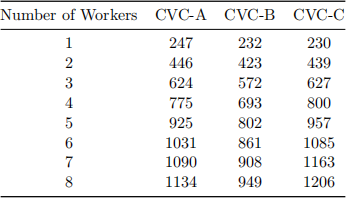
3. Suppose 8 workers are hired. To maximize the number of doses given, the government should allocate [ Answer03A ] workers to CVC-A, [ Answer03B ] workers to CVC-B, and [ Answer03C ] workers to CVC-C.
4. Now suppose the government wants to give 2004 doses. The government always allocates the N workers among the three CVCs to maximize the amount of doses given. According to the government’s allocation rule, in order to given at least 2004 doses, N must be at least equal to [ Answer04 ].
5. Olivia, Ryan, Kate and Joan can produce scarves and hats. The table below shows their time required to produce a scarf and their time required to produce a hat (in minutes).
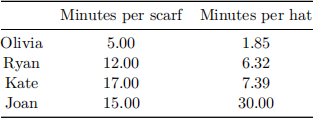
Assume they work eight hours per day. If we let the two people with a comparative advantage in producing scarves to specialize in the production of scarves, and the rest to produce hats, we will have a total of [ Answer05A ] scarves in a day and [ Answer05B ] hats in a day.
6. In an hour, Frank can shoot either 10 partridges or 240 sparrows, and Annie can shoot either 4 partridges or 160 sparrows. Suppose Frank has a total of 3 hours for work and Annie has 4 hours. Suppose Frank and Annie will make consumption and hunting decisions together. If they are going to consume 24 partridges in total, they will produce [ Answer06 ] sparrows.
Please refer to the background information below to answer the following three questions.
Robinson and Friday are the only people on Despair, a small island. They both produce grain and meat.
Let G denote the quantity of grain, and M denote the quantity of meat. The following equations summarize their production possibility curves (PPCs) per week.
Robinson: G = 21 − 7M
Friday: G = 144 − 8M
7. Suppose Despair is a closed economy. If Robinson and Friday would like to jointly consume 16 units of meat per week, they would be able to jointly consume a maximum of [ Answer07 ] of grain per week.
8. In this closed economy, any admissible terms of trade between Robinson and Friday have to be larger than [ Answer08A ] units of grain per unit of meat and smaller than [ Answer08B ] units of grain per unit of meat.
9. Suppose Despair is now opened up to trade with the rest of the world, and can trade at world terms
of trade of 9.5 units of grain per unit of meat. If Robinson and Friday would like to jointly consume 16 units of meat per week, they would be able to jointly consume a maximum of [ Answer09 ] units of grain per week.
![]()
![]() Please refer to the background information below to answer the following two questions.
Please refer to the background information below to answer the following two questions.
The demands for rocket fuel (tons per day) by SpaceY and SpaceZ are given by the following equations
SpaceY: QA = 1900 x 1.6P
SpaceZ: QB = 2000 x 1.8P
10. We know that the market demand (consisting of SpaceY and SpaceZ) should look like the graph below.
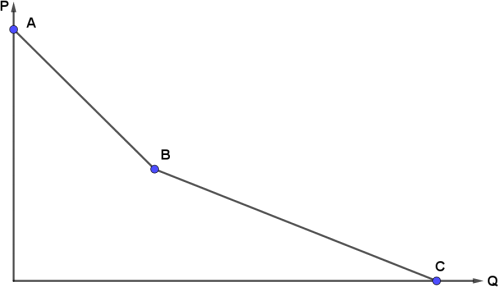
We can identify the three points as:

11. Given this market demand for rocket fuel, at the price of 50 dollars per ton, the consumer surplus in this market is [ Answer11 ] dollars per day.
Event 1: A scientific report says consumption of salmon can help reduce the risk of lung cancer.
Event 2: The price of diesel, which fishing vessels use, decreases.
We can predict [ Answer12A ] in the equilibrium price
A) an increase
B) a decrease
C) an uncertain change
and [ Answer12B ] in the equilibrium quantity.
A) an increase
B) a decrease
C) an uncertain change
13. Wineries make wine from grapes. In making wine, the wineries produce grapeseed oil as a by-product. This oil is then used to cook and bake. How many of the following events would cause an increase in the supply of wine?
(1) There is an increasing trend in the consumption of beer.
(2) The wage rate of winery workers falls.
(3) The price of grapeseed oil falls.
(4) A new technology lowers the cost of fried foods.
A) 0
B) 1
C) 2
D) 3
E) 4
[ Answer13 ]
![]() (1) The government subsidizes new electric airplane production.
(1) The government subsidizes new electric airplane production.
(2) Scientists discover a way to make aviation fuel from agricultural waste.
(3) Government increases the tax on aviation fuel.
(4) The price of crude oil rises.
A) 0
B) 1
C) 2
D) 3
E) 4
[ Answer14 ]
Please refer to the background information below to answer the following two questions.
The demand curve for asparagus takes the form of
QA = 2240 x 4.8PA x 1.8PB
where PA is the price of asparagus, and PB is the price of beans. At one equilibrium, QA = 14.76 and the cross-price elasticity between asparagus and beans is x2.3.
15. Then we can compute that PB = [ Answer15 ] at the equilibrium.
16. We can further compute that PA = [ Answer16 ]
17. At the current equilibrium point, the price elasticity of demand for soda is x0.6 and the price elasticity of supply for soda is 1.13. Suppose the demand decreases by 2.5%. This leads to a decrease of [ Answer17A ]% in the equilibrium price and a decrease of [ Answer17B ]% in the equilibrium quantity.
18. After a new per-unit subsidy of $4.7 is introduced on cinema tickets, we observe that the price of cinema tickets paid by consumers decreases by $3.1. What can we conclude?
A) Demand for cinema tickets is relatively more price elastic than the supply
B) Demand for cinema tickets is relatively less price elastic than the supply
C) The price elasticity of demand for cinema tickets is the same as the price elasticity of supply.
D) We cannot draw any conclusion on demand and supply elasticities of cinema tickets.
[ Answer18 ]
19. The supply curve is linear and upward sloping and the demand curve is linear and downward sloping. How many of the following statements is/are TRUE?
(1) When a per unit tax is imposed, the decrease in overall benefifit received by consumers and producers is always more than the gain to the government in tax revenue.
(2) For the same amount of tax per unit imposed, deadweight loss is smaller when the demand and/or supply is more price elastic.
(3) Consider a per unit tax. If buyers are more price elastic than sellers, buyers will bear less burden of the tax.
(4) If the government levies a tax of 1 dollar for each unit of a good, the price of the good increases by less than 1 dollar.
A) 0
B) 1
C) 2
D) 3
E) 4
[ Answer19 ]
Please refer to the background information below to answer the following three questions.
Consider the following supply and demand schedule for college education.
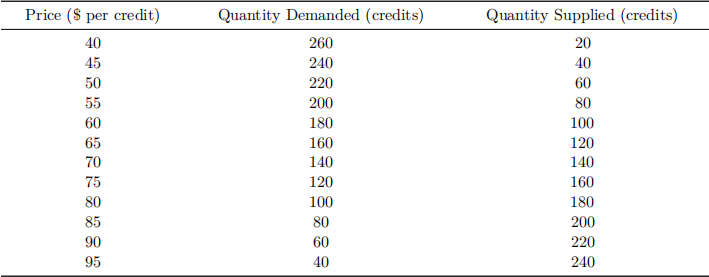
20. Suppose initially the college education market is in an unregulated equilibrium. If the government imposes on sellers a tax of $10 for each credit sold, the new equilibrium price paid by the consumers will be $[ Answer20 ].
21. Given the above information, the government’s tax revenue will be $[ Answer21 ].
22. Suppose initially the college education market is in an unregulated equilibrium. If the government imposes on sellers a subsidy of $10 for each unit of the credit sold, the new equilibrium quantity would be [ Answer22 ] units.
Please refer to the background information below to answer the following two questions.
The residents of Vancouver complain to the government that rent (dollars per square foot) is too high. The administration promises to consider a rent control policy proposed by residents. The market supply and demand curves of rental property are given by the following equations.
Demand: Q = 200 x 1.5P million square feet
Supply: Q = 4.8P million square feet
23. Consider a price ceiling on rent at 15 dollars per square foot. At this price ceiling, there will be a shortage of [ Answer23 ] million square feet.
24. At this proposed price ceiling, producer surplus is expected to be [ Answer24A ] million dollars per
year and the maximum possible consumer surplus will be [ Answer24B ] million dollars per year.
Please refer to the background information below to answer the following three questions.
The market demand for widgets is given as follows.
Demand: P = 1152 x 8Q dollars per widget
Suppose that the government imposes a price ceiling at 288 dollars per widget. After the ceiling is imposed, 36 units are produced and traded.
25. After the ceiling is imposed, there will be an excess demand of [ Answer25 ] units.
26. If there is a competitive market for bribery to determine the allocation, the equilibrium bribe for the right to purchase one unit of widget is [ Answer26 ] dollars.
27. If there is a competitive market for bribery to determine the allocation, the consumer surplus is [ Answer27 ] dollars.
Please refer to the background information below to answer the following five questions.
Royal Air Force (RAF) mechanics protect airplanes against gremlins, a highly opportunistic species of saboteur. The demand and supply curves for protection are given by the following equations.
Demand: Q = 200 − P thousand planes protected per year
Supply: Q = 8.5P − 85 thousand planes protected per year
where P is in pounds per plane. The social marginal benefit (SMB) is given by the following equation
Q = 200 x 0.9 × SMB thousand planes protected per year
and the private marginal cost and social marginal cost are identical.
28. If the market is left unregulated, the market equilibrium level of protection is [ Answer28A ] thousand planes protected per year, at a price of [ Answer28B ] pounds per plane.
29. The total economic surplus to society from the market equilibrium level of protection is [ Answer29 ] thousand pounds per year.
30. The socially efficient level of protection is [ Answer30 ] thousand planes protected per year.
31. If the government applies a per unit subsidy on protection to achieve the socially efficient level, it should implement a per unit subsidy of [ Answer31 ] pounds per plane protected .
32. This per unit subsidy will cost the government a total of [ Answer32 ] thousand pounds of subsidy expenditure per year.
Please refer to the background information below to answer the following six questions.
Two firms, X and Y, have access to seven different production processes, each one of which has a different
cost (dollars) and produces a different amount of waste (tons) that society cannot recover. The information is summarized in the table below.
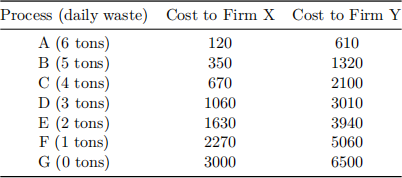
33. If waste production is unregulated, and negotiation between the firms and future generations is impossible, firm X will use the production process [ Answer33A ], firm Y will use the production process [ Answer33B ], and the total waste will be [ Answer33C ] tons per day.
34. Suppose initially there is no regulation on waste production (in particular, no tax is imposed on waste production), and the Natural Resources Department has recently decided to cut the total waste production by half. If the Natural Resources Department achieves this goal by requiring each firm to cut its waste production by half, the total cost of achieving this goal will be [ Answer34 ] dollars per day.
35. From society’s perspective, to cut waste production by half, it would be optimal for firm X to adopt process [ Answer35A ] and for firm Y to adopt process [ Answer35B ].
36. Continue to assume that the Natural Resources Department wants to cut total waste production by half. Suppose the Natural Resources Department decides to set a tax of T dollars on each ton of waste produced. To achieve the desired reduction in the waste production, T should be more than [ Answer36A ] and less than [ Answer36B ] dollars.
37. Continue from the previous question. Using this tax as a tool, the total cost of reducing the waste production by half is [ Answer37 ] dollars per day.
38. A good is called a ________ if the good is non-rival in consumption and non-excludable.
A) private good
B) common resource
C) club good
D) public good
[ Answer38 ]
Please refer to the background information below to answer the following three questions.
Gawain and Lancelot are knights. They are considering the joint installation of a Round Table in Arthur’s Kingdom so that all can gather and feast. Their marginal benefits from the Table are summarized by the following equations
Gawain: MBG = 100 − 5.5D
Lancelot: MBL = 68 − 2.5D
where D measures the diameter of the Table in feet and MBs are measured in pounds. In addition, MBs are constrained to be non-negative. For instance, when D = 1000, the equations described above would imply MBG = x5400 and MBL = x2432, but in this case, the “non-negative” constraint on MB means that we should instead interpret MBG = 0 and MBL = 0 for this D = 1000.
39. The total marginal benefit should look like the graph below (not to scale).
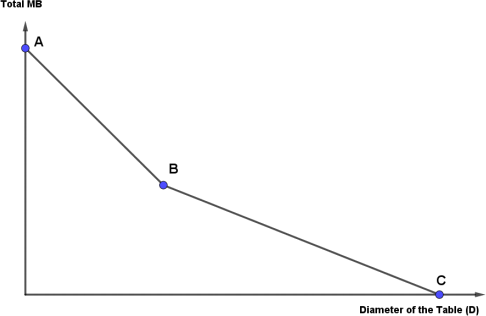
We can identify the three points as:

40. Suppose the marginal cost of producing a Table of diameter D is constant and equal to $22 per foot. Given this marginal cost, the socially optimal diameter of the table should be [ Answer40 ] feet.
41. Suppose the marginal cost of producing a Table of diameter D is equal to $(22 + D) per foot. Given this marginal cost, the socially optimal diameter of the table is [ Answer41 ] feet.
Please refer to the background information below to answer the following three questions.
There is a small public beach in Dystopia. The thieves of Dystopia, in total 20 of them, love to go to the beach to rob tourists but prefer not to when it is too competitive. In particular, if n thieves share the beach together, each individual steals goods worth 16.5 x n dollars. Suppose n can only take integer numbers.
42. If the thieves make their decisions individually, then [ Answer42 ] thieves will go to the beach in equilibrium.
43. For the guild of thieves, the socially optimal number of beach thieves is [ Answer43 ].
44. The socially optimal number of thieves will go to the beach in equilibrium if the guild charges each thief an entrance fee of at least [ Answer44A ] and less than [ Answer44B ] dollars.
Please refer to the background information below to answer the following four questions.
The market for buttons is perfectly competitive. Joe’s Button Factory is one of many perfectly competitive firms. Assume that the only variable input required for production is workers. The following table shows the relationship between the number of workers hired and the total output (boxes of buttons produced).
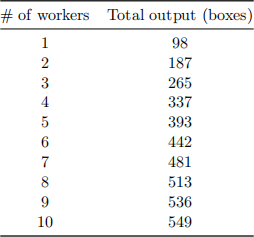
Joe pays a fixed cost of $560 per day, and to each employee a wage of $72 per day. The price of buttons is $1.43 per box.
45. Given such information, we can calculate the marginal product due to the 4-th worker is [ Answer45 ].
46. Given such information, in the short run, Joe should hire [ Answer46A ] workers, and thus produce [ Answer46B ] boxes of buttons.
47. Consequently, in the short run, Joe will make a profit of [ Answer47 ] dollars.
48. Suppose the fixed cost is $840 per day. In the short run, Joe should hire [ Answer48A ] workers and thus produce [ Answer48B ] boxes of buttons.
49. Which of the following situations is likely to incur the least negotiation cost?
A) Classmates deciding on when their reunion should be held.
B) An employee negotiating with her employer for a raise.
C) Five roommates deciding on whether or not to install a CCTV camera in the entryway.
D) Sellers and buyers trading in a perfectly competitive market.
[ Answer49 ]
Please refer to the background information below to answer the following three questions.
A perfectly competitive market is initially in a long run equilibrium, with n identical firms (n can take non-integer values). The demand curve and the short-run supply curve are given as follows.
Demand: Q = 2300 − 3P thousand units
Supply: Q = 50P − 700 thousand units
50. The equilibrium price is [ Answer50A ] dollars per unit and the equilibrium quantity is [ Answer50B ] thousand units.
51. Suppose there is an increase in demand such that each consumer’s willingness to pay increases by
10 dollars, and supose this is a constant cost industry. Then, the quantity traded in the market is [ Answer51 ] thousand units when the market reaches a long run equilibrium again.
52. Continue with the previous question. Suppose the new entrants and the incumbent firms are all identical. After the increase in demand, 10 new firms eventually enter the market so that a new long run equilibrium is reached. The average cost curve of an individual firm is minimized at q = [ Answer52 ] thousand units.
53. The average cost at this quantity is [ Answer53 ] dollars per unit.
54. Facing a downward sloping linear demand curve P = A x BQ, a monopolist maximizes its profit and produces Q = 10, at which point the average total cost equals $45 and the price equals $100. We also know that the U-shaped average total cost (ATC) curve is at its minimum level when Q = 10. Given this information, we conclude that A = [ Answer54A ] and B = [ Answer54B ].
Please refer to the background information below to answer the following five questions.
Your mom is the monopoly supplier of jokes in (humorless) Ho Hum. She faces a demand curve and a marginal cost curve given by following equations
Demand: Q = 106 − 0.18P jokes per day
Marginal Cost: MC = 80 dollars per joke
Assume that jokes are perfectly divisible.
55. Your profit-maximizing mom would produce [ Answer55A ] jokes per day, and set a price of [ Answer55B ] dollars per joke.
56. The price elasticity of demand at the profit-maximizing quantity is [ Answer56 ]
57. The markup at the profit-maximizing quantity is [ Answer57 ] percent.
58. The socially efficient quantity is [ Answer58 ] jokes.
59. Compared to the socially efficient quantity, monopoly pricing leads to a deadweight loss of [ Answer59 ] dollars per day.
Please refer to the background information below to answer the following four questions.
A monopolist faces a demand curve of P = 190 x 0.8Q and has a constant marginal cost of $9. Assume that Q is perfectly divisible.
60. To maximize profit, the monopolist produces [ Answer60A ] units and charges [ Answer60B ] dollars.
61. If the government imposes a price ceiling at $10, the monopolist will produce [ Answer61 ] units.
62. If the government imposes a price ceiling at $10, the deadweight loss [ Answer62A ] (A. increases;
B. decreases) by [ Answer62B ] dollars compared to an unregulated market.
63. If the government imposes a price ceiling at $10, the monopolist will not exit the market in the long run if the fixed cost is [ Answer63A ] (A. more; B. less) than [ Answer63B ] dollars.
Please refer to the background information below to answer the following five questions.
RobbinGood sells financial trades to retail traders (r) and institutional traders (i) whose demand curves for financial trades are given by the following equations
Demand (r): Qr = 1000 − 80Pr thousand trades
Demand (i): Qi = (1000/10) − (80/10)Pi thousand trades
and the marginal cost is a constant $2 per trade for either kind of trader.
64. Suppose RobbinGood decides to set a single price for both groups, and maximize profits accordingly. Then, RobbinGood will sell [ Answer64 ] thousand trades.
65. When a single price is set, RobbinGood will charge a price of $[ Answer65 ] per trade.
66. Suppose RobbinGood decides to set one price for each group, and maximize profits accordingly. Then, RobbinGood will sell [ Answer66A ] thousands of trades to retail traders at a price of $[ Answer66B ] per trade.
67. And, it will sell [ Answer67A ] thousands of trades to institutional traders at a price of $[ Answer67B ] per trade.
68. The total consumer surplus under RobbinGood’s single-price scheme is [ Answer68 ] thousands dollars LESS THAN the total consumer surplus under RobbinGood’s dual-price scheme.
Please refer to the background information below to answer the following three questions.
A monopolist serves two geographically separated markets. In market A, the demand curve is
Q = 160 x 0.8P
and in market B, the demand curve is
Q = Y x 0.1P
where Y is a constant. The monopolist can set different prices and quantities in the two markets to maximize the combined profit. Suppose the monopolist produces at a constant marginal cost of $2.
69. When Y = 40, the monopolist supplies [ Answer69A ] units in market B at [ Answer69B ] dollars per unit.
70. When Y = 40, the lowest transportation cost between the two markets that prevents arbitrage equals [ Answer70 ] dollars.
![]()
71. An ice-cream shop is deciding how best to sell chocolate and vanilla soft-serve. The shop can either sell chocolate and vanilla separately in two small cups, or bundle them in one large cup with both flavors swirled together. Suppose the cost of supplying the soft-serve is zero. There are two customers in the market, and their willingness to pay for each flavor is summarized in the table below.

The shop can make a profit of [ Answer71 ] dollars.
2023-07-04